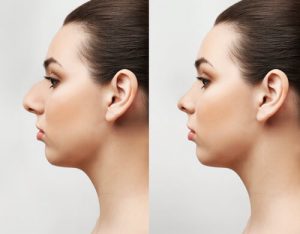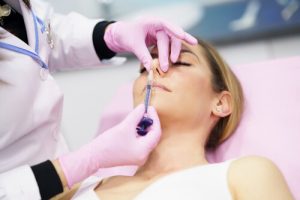Navigating through life with a deviated nasal septum can feel like an uphill struggle, impacting every breath you take. This common condition leads to chronic discomfort and frustrating respiratory issues for many. However, a glimmer of hope is on the horizon with breakthroughs in deviated nasal septum treatments. These innovative therapies, which range from non-invasive techniques to sophisticated surgeries, are making it easier than ever for individuals to breathe freely. Explore how these advancements change lives and promise a future filled with easy, unobstructed breaths.
Living life with a deviated septum
The nasal septum is the thin wall of bone and cartilage that separates your nostrils, ideally dividing your nose into two halves. However, it’s quite common for the septum to be off-centre or “deviated,” which means it leans more to one side than the other.
Deviated septum symptoms can be a variety of things. However, it’s important to note that not everyone with a deviated septum will experience symptoms. When symptoms do occur, they may include:
- Nasal Congestion: One of the most common symptoms is having a stuffy or runny nose. This may be worse on one side, and sometimes the side of the congestion may alternate.
- Difficulty Breathing: This is particularly noticeable when you have a cold or allergies, which can further narrow your nasal passages.
- Recurrent Sinus Infections: The deviation may interfere with the drainage of your sinuses, which can lead to repeated infections.
- Nosebleeds: The surface of your nasal septum can dry, increasing your risk of nosebleeds.
 Sleep Problems: Including sleep apnea symptoms like snoring and breathing cessation during sleep. A deviated septum can also cause frequent awakenings.
Sleep Problems: Including sleep apnea symptoms like snoring and breathing cessation during sleep. A deviated septum can also cause frequent awakenings.- Headache: Many people will experience headaches or facial pain.
- Postnasal Drip: This is a feeling of mucus continually running down the back of your throat.
- Noisy Breathing During Sleep: This is more common in infants and young children, especially if their condition is severe.
If you’re experiencing one or more of these symptoms and they’re causing concern or disrupting your life, it’s important to seek medical attention. While these symptoms can also be indicative of other conditions, a healthcare professional can help determine if a deviated septum is the cause and guide you through the treatment options best suited for your condition.
Nasal cavity defect and how it can be a badly deviated septum
A deviated septum can be caused by a variety of factors, including:
- Congenital Issues: Some people are born with a deviated septum. It happens during the development process in the womb, leading to a misaligned nasal septum at birth.
- Growth and Development: As a person grows, the septum can sometimes shift or deviate to one side. This is particularly common during the adolescent growth spurt.
- Injury or Trauma: This is the most common cause of a deviated septum in adults. Injuries to the nose, such as falls, sports injuries, or car accidents, can knock the septum out of alignment. This can happen even with minor injuries if they are not treated correctly.
- Normal Aging Process: As we age, cartilage and bone structure changes can sometimes lead to a deviated septum.
- Previous Surgery or Medical Procedure: Any or medical procedure involving the nasal area can potentially lead to a deviation in the nasal septum.
It’s important to note that a slight deviation in the septum is quite common and doesn’t usually cause any health problems. But suppose you’re experiencing symptoms like frequent nosebleeds, difficulty breathing, recurrent sinus infections, or sleep problems. In that case, it’s a good idea to consult a healthcare provider to see if a deviated septum could be the cause.
Non-Surgical Treatments: Beyond the Operating Room
When it comes to treating a deviated nasal septum, several non-surgical options can provide relief from symptoms. However, it’s important to note that these treatments primarily manage symptoms and do not correct the septal deviation itself.
1. Nasal Steroid Sprays
- Pros: Steroid sprays can reduce inflammation in your nasal passages, improving symptoms of nasal obstruction. They are easy to use and non-invasive.
- Cons: Nasal spray provides temporary relief and needs to be used regularly for continued effectiveness. Long-term use may cause side effects such as nosebleeds or discomfort.
2. Antihistamines
- Pros: These can help if your symptoms include allergies or if a deviated septum leads to frequent sinus infections. They reduce inflammation and mucus production.
- Cons: Antihistamines can have side effects like drowsiness, dry mouth, and dizziness. They also do not fix the underlying deviation.
3. Decongestants
- Pros: Decongestants can provide temporary relief from nasal congestion.
- Cons: These are not recommended for long-term use as they can cause rebound congestion (worsening congestion after the medication is stopped). They can also raise blood pressure and cause palpitations, particularly in individuals with heart conditions.
4. Nasal Strips
- Pros: Nasal strips can be applied to the outside of the nose to help open the nasal passage, improving airflow and breathing during sleep.
- Cons: The effectiveness can vary from person to person, and they do not provide a long-term solution for the problem. They are also visible, which some people may find uncomfortable or embarrassing.
5. Humidifiers
- Pros: Humidifiers add moisture to the air, soothing dry nasal passages and promoting better breathing.
- Cons: They do not address the physical deviation, and overuse can lead to mould or bacteria growth if the humidifier isn’t cleaned properly.
As always, discussing these options with a healthcare professional who can guide you towards the best treatment based on your condition and health history is essential. It’s also crucial to remember that while these options can manage the symptoms of a deviated nasal septum, they do not correct the deviation itself. Surgical intervention may be required for a long-term solution if symptoms are severe or persistent.
Surgical Options: Decoding Septoplasty and Rhinoplasty
Surgical intervention for a deviated nasal septum primarily involves septoplasty and rhinoplasty. These surgeries aim to correct the alignment of the nasal cavity, significantly improving or completely resolving symptoms.
1. Septoplasty
Septoplasty is a surgical procedure specifically designed to correct a deviated septum.
 Pre-Operation Care: Before , you may be asked to stop certain medications that could increase bleeding. Smoking should be avoided as it can slow the healing process.
Pre-Operation Care: Before , you may be asked to stop certain medications that could increase bleeding. Smoking should be avoided as it can slow the healing process.- Procedure: During the operation, the doctor works through the nostrils, making an incision in the septum to remove or reshape the deviated cartilage and bone. The procedure typically takes 60-90 minutes.
- Post-Operation Care: After , nasal packing or splints may be placed in the nostrils to support the septum. You’ll need to avoid strenuous activities for several weeks. Regular follow-up appointments will be needed to monitor healing.
- Recovery Times: The initial healing process typically takes 1-2 weeks, but full recovery can take up to a few months.
- Success Rates: Septoplasty has high success rates, with most patients experiencing significant improvement in breathing and other symptoms. However, complications, though rare, can occur, including excessive bleeding, infection, or a change in the shape of the nose.
2. Rhinoplasty
Rhinoplasty, often referred to as a “nose job”, can also address a deviated septum, especially if cosmetic changes to the nose are desired simultaneously.
- Pre-Operation Care: Similar to septoplasty, you may be asked to stop certain medications and smoking.
- Procedure: Rhinoplasty is a more complex operation that reshapes the nose’s bone, cartilage, and skin, in addition to correcting septal deviation. This procedure may take 1.5-3 hours.
- Post-Operation Care: Post-surgical care includes using a nasal splint for the first week to support the new shape. Avoiding strenuous activities and wearing glasses is also recommended in the early recovery period.
- Recovery Times: Full recovery from rhinoplasty may take several months to a year as swelling gradually subsides.
- Success Rates: Rhinoplasty generally has high patient satisfaction rates for both cosmetic and functional outcomes. Complications, though rare, include bleeding, infection, and undesirable cosmetic result.
Remember that each individual’s case is different, and these timelines and outcomes can vary. Always consult with a healthcare professional or a specialized doctor to discuss the best option for your specific condition.
Breakthroughs and Future Treatments: A Look Ahead
Several exciting research areas are in progress regarding emerging deviated septum treatment plans.
- Minimally Invasive Techniques: Researchers are continually seeking to improve the current surgical methods used to correct a deviated septum. The goal is to create minimally invasive procedures with shorter recovery times and fewer complications.
- Laser Septoplasty: This is a relatively new technique where lasers are used to reshape the cartilage of the septum without invasive . It’s generally less painful and has a shorter recovery time than traditional . However, it may not be suitable for severe cases of a deviated septum.
- Use of Biodegradable Implants: This is a technique in which biodegradable spacers are used post-septoplasty to prevent adhesions and maintain the corrected septum’s position.
- Improving Diagnosis: Another focus is on improving diagnostic techniques for deviated septum and related conditions. More precise diagnoses may help to better tailor treatment to individual patients and improve outcomes.
- Personalized Treatment Plans: A more personalized approach to treatment is being studied, which involves developing individualized treatment plans based on the specific nature and degree of the patient’s septal deviation and symptoms.
These advancements are just the tip of the iceberg. With continuing research and clinical trials, more innovative solutions are likely to emerge for managing and treating a deviated septum.
 It’s important to remember that while these treatment options may be promising, they are still under development and not yet widely available. As always, it’s best to discuss with your healthcare provider for the most current and applicable treatment options for your condition.
It’s important to remember that while these treatment options may be promising, they are still under development and not yet widely available. As always, it’s best to discuss with your healthcare provider for the most current and applicable treatment options for your condition.
If you’ve been experiencing persistent symptoms like frequent nosebleeds, difficulty breathing, recurrent sinus infections, or sleep problems, don’t ignore them. These might be signs of a severely deviated septum. We know that health concerns like these can feel overwhelming and even scary, but rest assured, you’re not alone. There are effective treatments available that can dramatically improve your quality of life.
We encourage you not to let uncertainty hold you back. If you suspect you might need a deviated septum , take that crucial step and seek our professional medical advice. Our team is here to support you, providing expert diagnosis, discussing your treatment options, and guiding you on the path towards better health and improved well-being. Remember, every breath you take should be a comfortable one. Let’s make that a reality for you. Reach out to us today – your health deserves it!
References:
https://www.mayoclinic.org/diseases-conditions/deviated-septum/diagnosis-treatment/drc-20351716
https://my.clevelandclinic.org/health/diseases/16924-deviated-septum
https://www.healthdirect.gov.au/deviated-septum


 Sleep Problems: Including sleep apnea symptoms like snoring and breathing cessation during sleep. A deviated septum can also cause frequent awakenings.
Sleep Problems: Including sleep apnea symptoms like snoring and breathing cessation during sleep. A deviated septum can also cause frequent awakenings. Pre-Operation Care: Before , you may be asked to stop certain medications that could increase bleeding. Smoking should be avoided as it can slow the healing process.
Pre-Operation Care: Before , you may be asked to stop certain medications that could increase bleeding. Smoking should be avoided as it can slow the healing process.